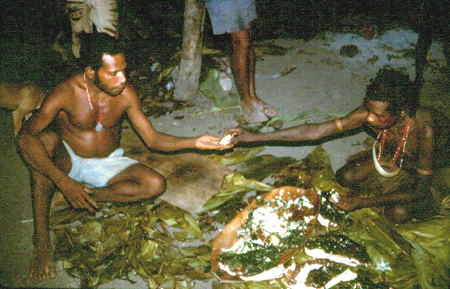
With a culture centered around reciprocity and spirituality, it is no wonder that marriage is a critical characteristic of Gebusi life. In truth, it is in every society that “kinship and marriages are important,” and how those relationships are manifested, informs the cultural narrative (66). Within Gebusi society are clans and kinships. Clans are member groups that in theory contain non-blood related relatives, kinships are the makeup of families by marriage. The tools necessary to trace lineage are not as well developed in Gebusi life as they are in 20th or 21st century Western civilizations. There is an understanding in Gebusi life however, that “clan members should generally not marry each other,” although it might be inaccurate to assume that it never occurs (66). This may be one way to safeguard against interfamilial marriage. Clanship is passed down to the child generation in a patriarchal fashion, but it is more accurate to refer to this transfer of entitlement as ‘patrilineages’ part of a ‘patriclan’ in the case of the Gebusi.
To fully appreciate patrilineage within Gebusi culture, is to fully accept some of their cultural expectations going passed simply male dominance; for example, marriages are not arranged. These unions may be highly suggested by a brother or a father, but if a Gebusi women holds “objections to marrying a certain man, her wishes usually hold sway,” as opposed to other cultures that force unions through arranged marriages and limit a woman’s ability to advocate for self (70). While the marriages “paired between clans or linages,” are “crucial for forming alliances,” it is also possible for young couples to bend the expectations altogether, that is, fall in love, runaway, be wed, perhaps receive strong condemnation, but ultimately have their union honored by the collective (67, 70). On one hand, it is true “Gebusi communities are largely ‘endogamous,’” meaning, many marriages are between partners “from a hamlet close by,” or from the same village (70). On the other hand, it is also true that Gebusi “generally marry outside [their] clan,” generating reciprocity through ‘sister-exchange’ or through ‘brideprice’ as a means of wealth exchange (71).
“Sorcery accusation are especially likely between kin groups linked by a marriage that has not been reciprocated,” (71).
A reciprocated union is demonstrated, for example, when “two couples…live together as a joint family,” in which the wives are in fact the result of a sister-exchange (71). The label of brother or sister may not necessarily donate to what Western cultures consider siblings but may refer to the Western view of cousins or aunts and uncles. According to Bruce Knauft, who lived on Gebusi settlements for extended periods of time, over half of the first-time marriages he recorded, were the results of sister-exchanges. Resentment due to the lack of bridewealth can occur after the loss of life in spousal relationships, which can contribute to an unreciprocated union provocation, such as a sorcery accusation. Knauft reports that unreciprocated marriages accounts for over 70% of sorcery accusations in marital samplings (73). Failure to reciprocate a marital union is the cause of many sorcery accusations.
“Statistics reveal that persons related by marriage are more than 3 times likely to accuse one another of sorcery,” (73).
For fathers-in-law and sons-in-law, the frequency of sorcery accusations was as high as “15 times greater than would be expected,” in the 1980’s when the statistics were taken (73). The repercussion of sorcery accusation if substantiated by spiritual investigation is execution; consequently, “[k]illings of Gebusi were remarkably frequent,” nearly one-third of all adult deaths were homicides (73). An ethnocentric view may regard these statistics as alarming. For Gebusi, “it wasn’t murder to execute sorcerers,” indeed, cultural relativism teaches anthropologists to keep things in context and not pass judgement (75). At the time, with respect to Gebusi culture, “persons whose close relatives had been executed as sorcerers often lived with…the families of the killers,” as part of the kogwayay –collective good company–of their kinship (71, 74).
Once more is this idea of reciprocity on which Gebusi culture rests. Kinship and non-kinship are interwoven through the patriclans and friendships across the village. For generations, given that “Gebusi marriage is based on ‘person-to-person’ exchange,” an unreciprocated union might have resulted in a sorcery execution (73). However, more recently, “[s]ince 1989…not a single Gebusi has been killed,” a likely sign that new generations are modernizing or restructuring their social organization (76). In addition to the dramatic reduction in sorcery attacks, the improvement on nutrition has afforded longer lives for the Gebusi since the 1980’s, “many older men and women now live long enough to enjoy grandchildren,” adding new tapestry to the patterns of clanship, ‘co-residence,’ and kinship for the Gebusi (77).
